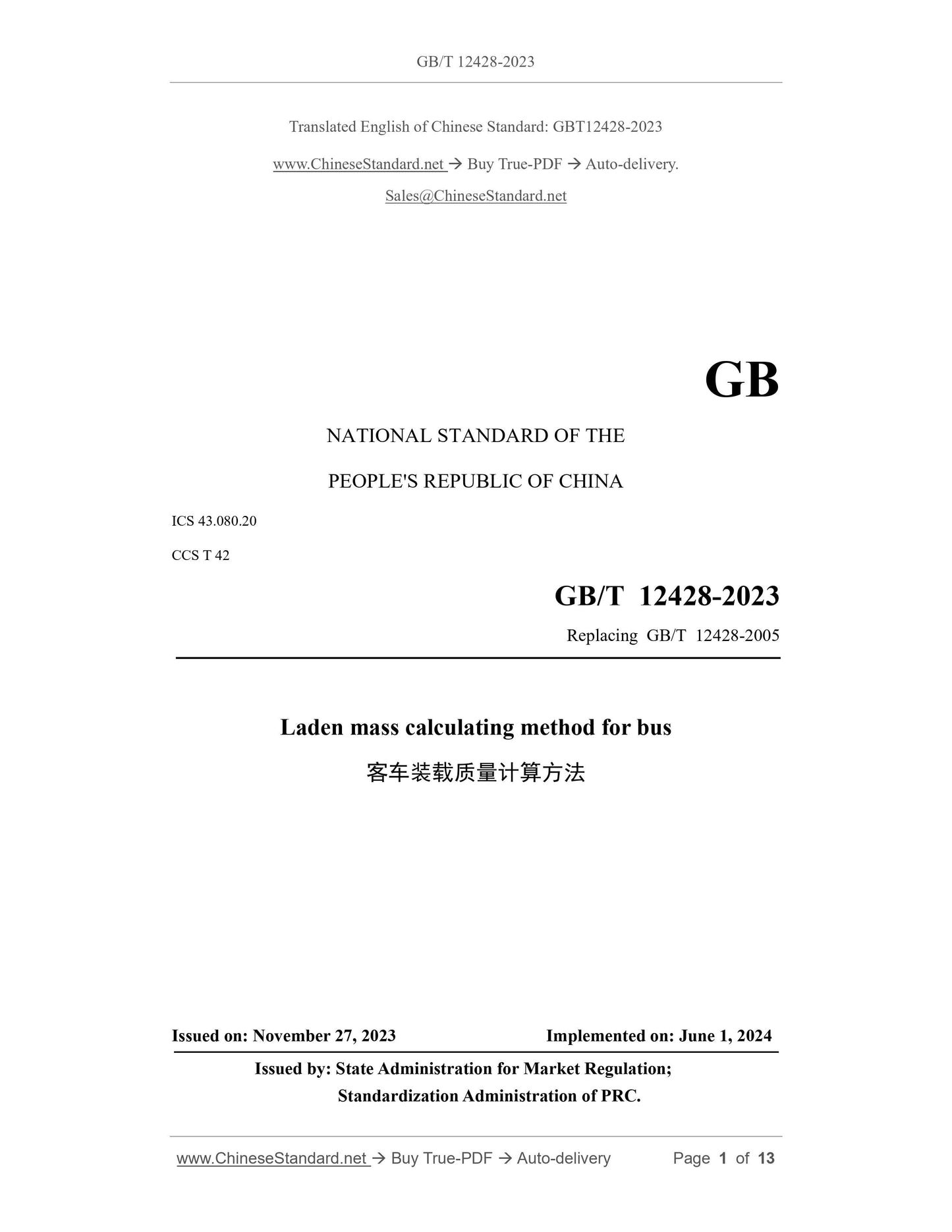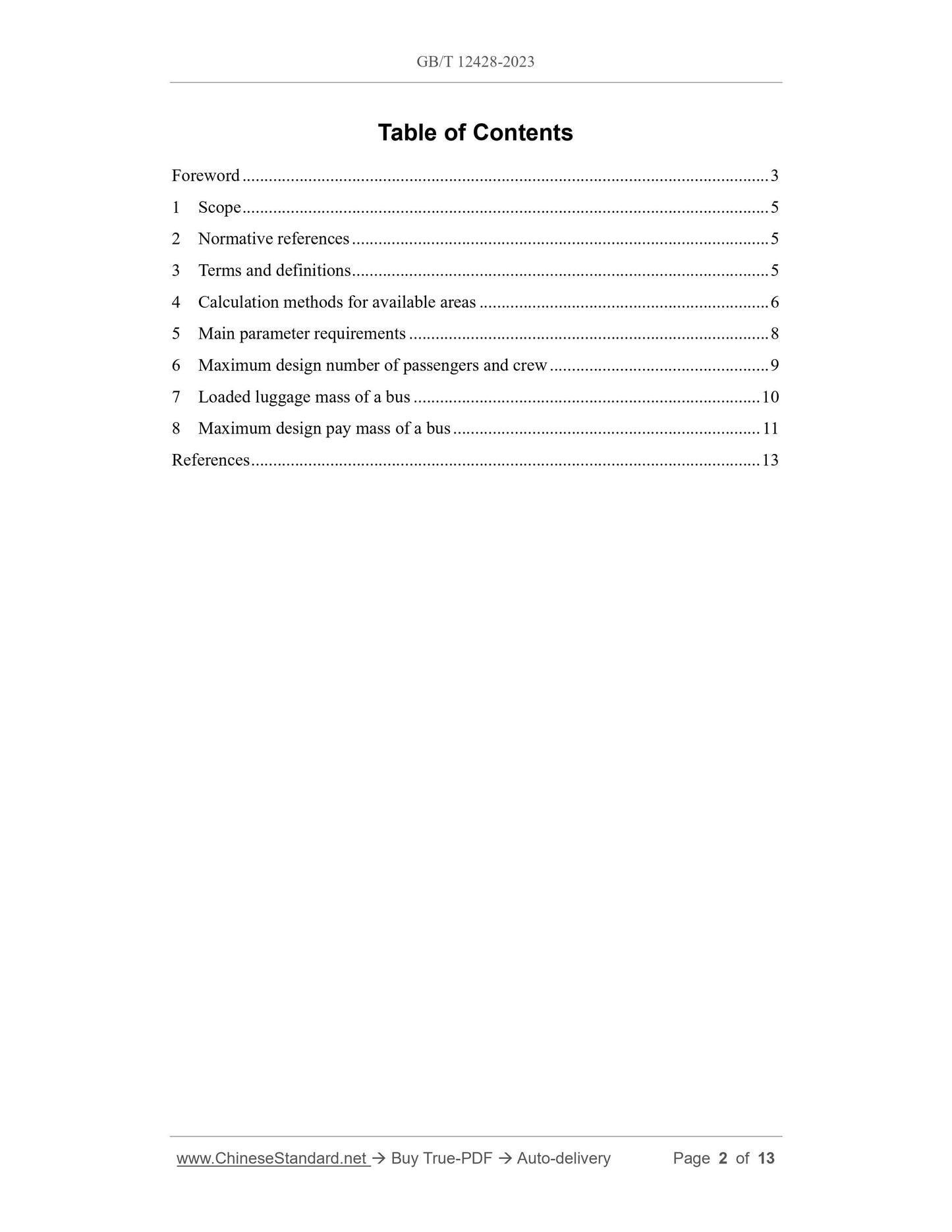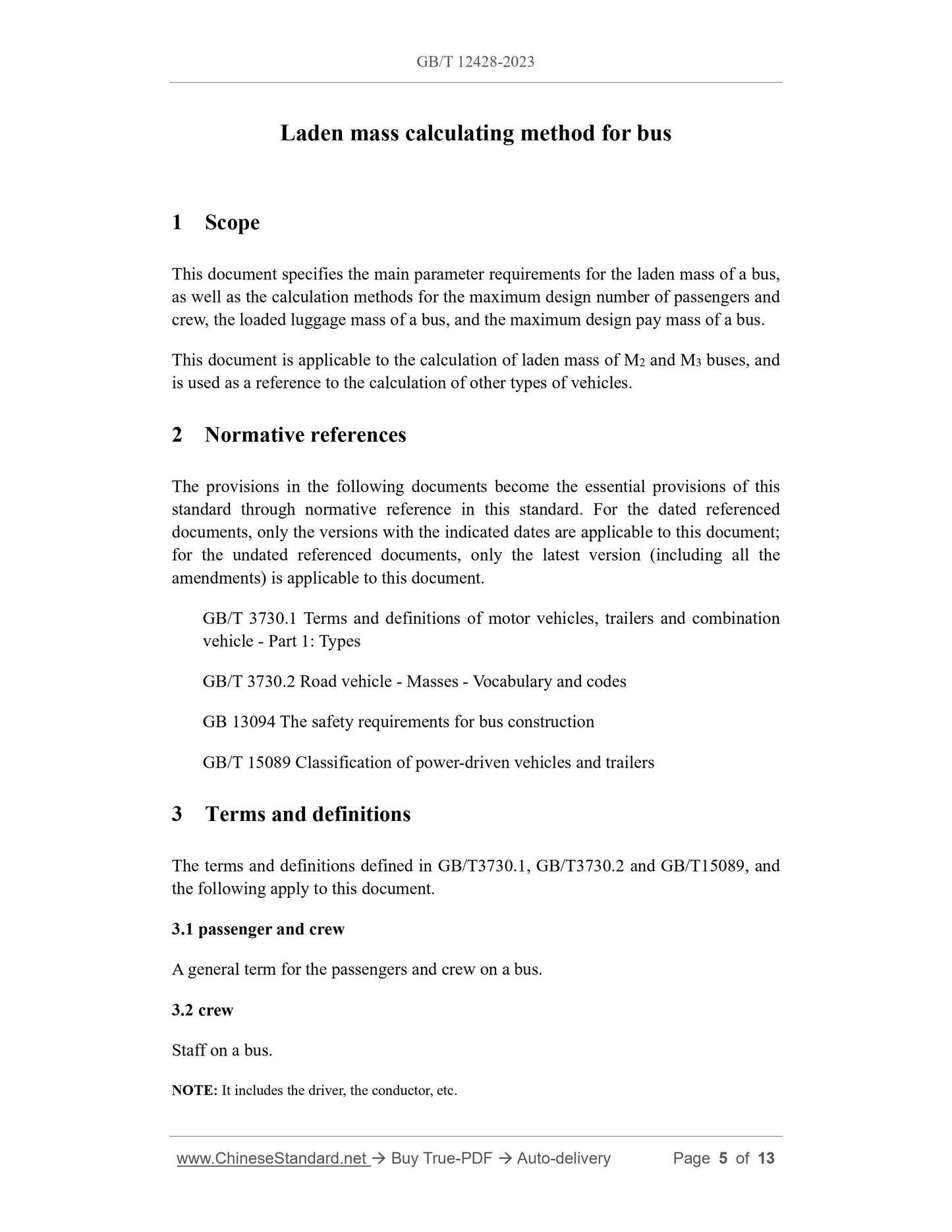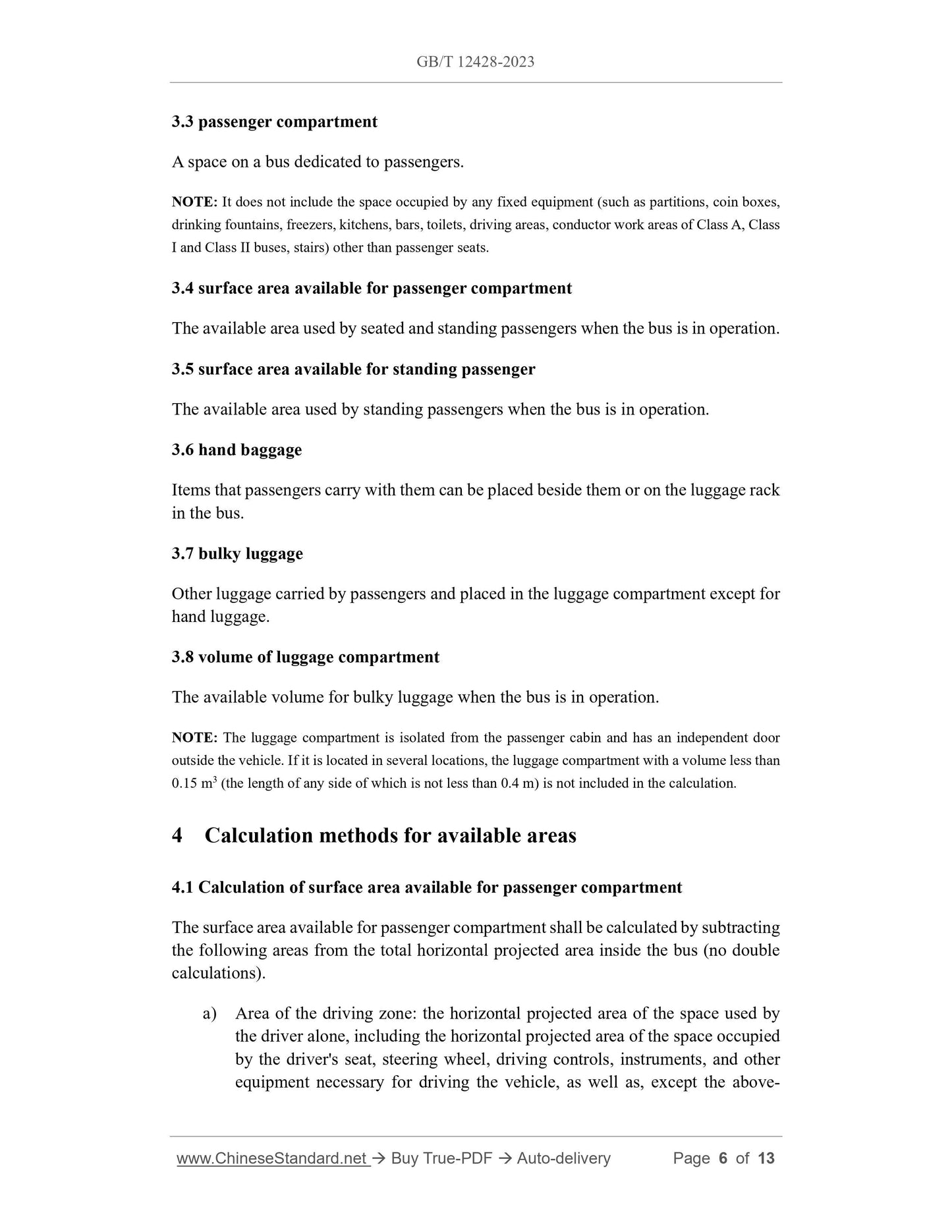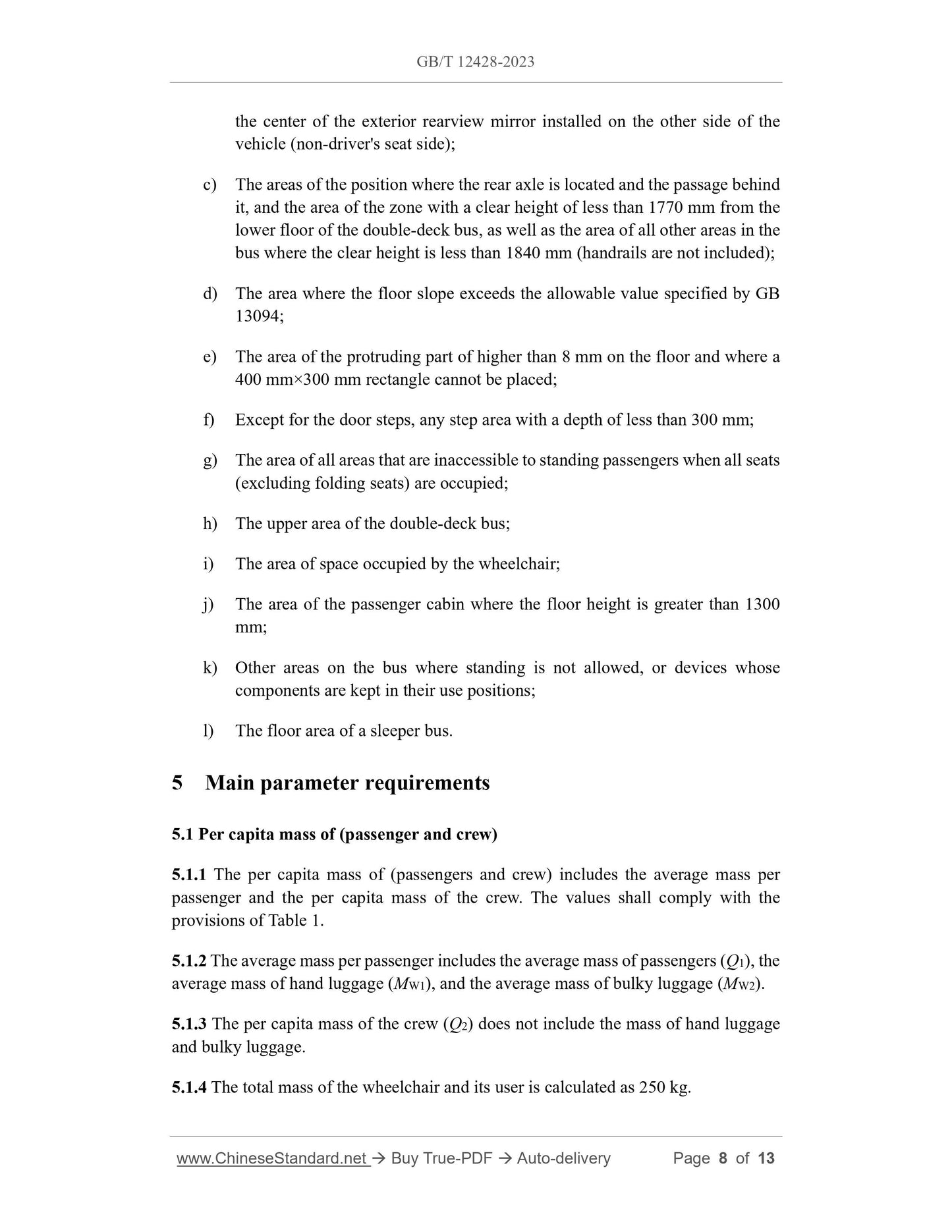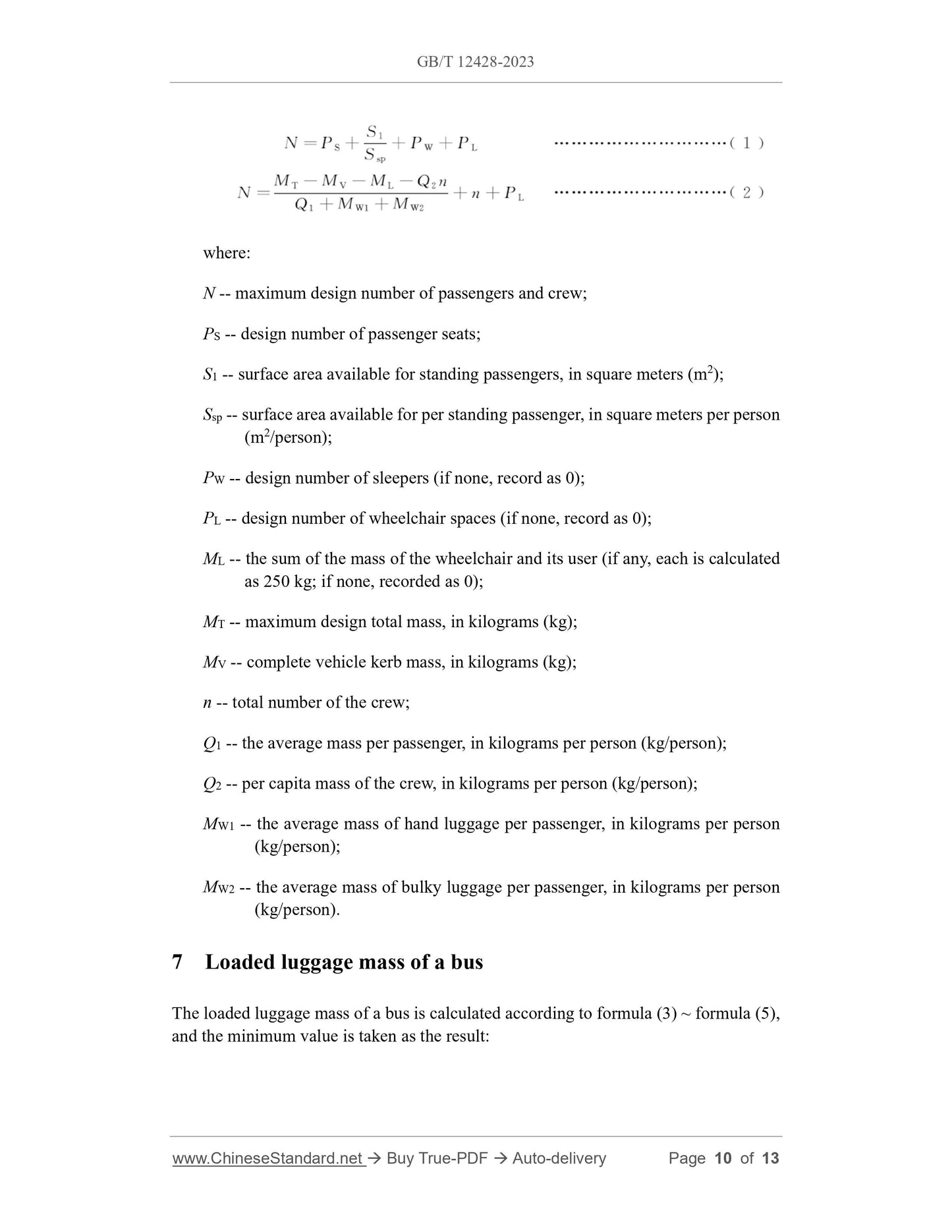1
/
of
6
www.ChineseStandard.us -- Field Test Asia Pte. Ltd.
GB/T 12428-2023 English PDF (GB/T12428-2023)
GB/T 12428-2023 English PDF (GB/T12428-2023)
Regular price
$170.00
Regular price
Sale price
$170.00
Unit price
/
per
Shipping calculated at checkout.
Couldn't load pickup availability
GB/T 12428-2023: Laden mass calculating method for bus
Delivery: 9 seconds. Download (& Email) true-PDF + Invoice.
Get Quotation: Click GB/T 12428-2023 (Self-service in 1-minute)
Historical versions (Master-website): GB/T 12428-2023
Preview True-PDF (Reload/Scroll-down if blank)
GB/T 12428-2023
GB
NATIONAL STANDARD OF THE
PEOPLE'S REPUBLIC OF CHINA
ICS 43.080.20
CCS T 42
Replacing GB/T 12428-2005
Laden mass calculating method for bus
ISSUED ON: NOVEMBER 27, 2023
IMPLEMENTED ON: JUNE 1, 2024
Issued by: State Administration for Market Regulation;
Standardization Administration of PRC.
Table of Contents
Foreword ... 3
1 Scope ... 5
2 Normative references ... 5
3 Terms and definitions ... 5
4 Calculation methods for available areas ... 6
5 Main parameter requirements ... 8
6 Maximum design number of passengers and crew ... 9
7 Loaded luggage mass of a bus ... 10
8 Maximum design pay mass of a bus ... 11
References ... 13
Laden mass calculating method for bus
1 Scope
This document specifies the main parameter requirements for the laden mass of a bus,
as well as the calculation methods for the maximum design number of passengers and
crew, the loaded luggage mass of a bus, and the maximum design pay mass of a bus.
This document is applicable to the calculation of laden mass of M2 and M3 buses, and
is used as a reference to the calculation of other types of vehicles.
2 Normative references
The provisions in the following documents become the essential provisions of this
standard through normative reference in this standard. For the dated referenced
documents, only the versions with the indicated dates are applicable to this document;
for the undated referenced documents, only the latest version (including all the
amendments) is applicable to this document.
GB/T 3730.1 Terms and definitions of motor vehicles, trailers and combination
vehicle - Part 1: Types
GB/T 3730.2 Road vehicle - Masses - Vocabulary and codes
GB 13094 The safety requirements for bus construction
GB/T 15089 Classification of power-driven vehicles and trailers
3 Terms and definitions
The terms and definitions defined in GB/T3730.1, GB/T3730.2 and GB/T15089, and
the following apply to this document.
3.1 passenger and crew
A general term for the passengers and crew on a bus.
3.2 crew
Staff on a bus.
NOTE: It includes the driver, the conductor, etc.
3.3 passenger compartment
A space on a bus dedicated to passengers.
NOTE: It does not include the space occupied by any fixed equipment (such as partitions, coin boxes,
drinking fountains, freezers, kitchens, bars, toilets, driving areas, conductor work areas of Class A, Class
I and Class II buses, stairs) other than passenger seats.
3.4 surface area available for passenger compartment
The available area used by seated and standing passengers when the bus is in operation.
3.5 surface area available for standing passenger
The available area used by standing passengers when the bus is in operation.
3.6 hand baggage
Items that passengers carry with them can be placed beside them or on the luggage rack
in the bus.
3.7 bulky luggage
Other luggage carried by passengers and placed in the luggage compartment except for
hand luggage.
3.8 volume of luggage compartment
The available volume for bulky luggage when the bus is in operation.
NOTE: The luggage compartment is isolated from the passenger cabin and has an independent door
outside the vehicle. If it is located in several locations, the luggage compartment with a volume less than
0.15 m3 (the length of any side of which is not less than 0.4 m) is not included in the calculation.
4 Calculation methods for available areas
4.1 Calculation of surface area available for passenger compartment
The surface area available for passenger compartment shall be calculated by subtracting
the following areas from the total horizontal projected area inside the bus (no double
calculations).
a) Area of the driving zone: the horizontal projected area of the space used by
the driver alone, including the horizontal projected area of the space occupied
by the driver's seat, steering wheel, driving controls, instruments, and other
equipment necessary for driving the vehicle, as well as, except the above-
the center of the exterior rearview mirror installed on the other side of the
vehicle (non-driver's seat side);
c) The areas of the position where the rear axle is located and the passage behind
it, and the area of the zone with a clear height of less than 1770 mm from the
lower floor of the double-deck bus, as well as the area of all other areas in the
bus where the clear height is less than 1840 mm (handrails are not included);
d) The area where the floor slope exceeds the allowable value specified by GB
13094;
e) The area of the protruding part of higher than 8 mm on the floor and where a
400 mm×300 mm rectangle cannot be placed;
f) Except for the door steps, any step area with a depth of less than 300 mm;
g) The area of all areas that are inaccessible to standing passengers when all seats
(excluding folding seats) are occupied;
h) The upper area of the double-deck bus;
i) The area of space occupied by the wheelchair;
j) The area of the passenger cabin where the floor height is greater than 1300
mm;
k) Other areas on the bus where standing is not allowed, or devices whose
components are kept in their use positions;
l) The floor area of a sleeper bus.
5 Main parameter requirements
5.1 Per capita mass of (passenger and crew)
5.1.1 The per capita mass of (passengers and crew) includes the average mass per
passenger and the per capita mass of the crew. The values shall comply with the
provisions of Table 1.
5.1.2 The average mass per passenger includes the average mass of passengers (Q1), the
average mass of hand luggage (MW1), and the average mass of bulky luggage (MW2).
5.1.3 The per capita mass of the crew (Q2) does not include the mass of hand luggage
and bulky luggage.
5.1.4 The total mass of the wheelchair and its user is calculated as 250 kg.
where:
N -- maximum design number of passengers and crew;
PS -- design number of passenger seats;
S1 -- surface area available for standing passengers, in square meters (m2);
Ssp -- surface area available for per standing passenger, in square meters per person
(m2/person);
PW -- design number of sleepers (if none, record as 0);
PL -- design number of wheelchair spaces (if none, record as 0);
ML -- the sum of the mass of the wheelchair and its user (if any, each is calculated
as 250 kg; if none, recorded as 0);
MT -- maximum design total mass, in kilograms (kg);
MV -- complete vehicle kerb mass, in kilograms (kg);
n -- total number of the crew;
Q1 -- the average mass per passenger, in kilograms per person (kg/person);
Q2 -- per capita mass of the crew, in kilograms per person (kg/person);
MW1 -- the average mass of hand luggage per passenger, in kilograms per person
(kg/person);
MW2 -- the average mass of bulky luggage per passenger, in kilograms per person
(kg/person).
7 Loaded luggage mass of a bus
The loaded luggage mass of a bus is calculated according to formula (3) ~ formula (5),
and the minimum value is taken as the result:
GB/T 12428-2023
GB
NATIONAL STANDARD OF THE
PEOPLE'S REPUBLIC OF CHINA
ICS 43.080.20
CCS T 42
Replacing GB/T 12428-2005
Laden mass calculating method for bus
ISSUED ON: NOVEMBER 27, 2023
IMPLEMENTED ON: JUNE 1, 2024
Issued by: State Administration for Market Regulation;
Standardization Administration of PRC.
Table of Contents
Foreword ... 3
1 Scope ... 5
2 Normative references ... 5
3 Terms and definitions ... 5
4 Calculation methods for available areas ... 6
5 Main parameter requirements ... 8
6 Maximum design number of passengers and crew ... 9
7 Loaded luggage mass of a bus ... 10
8 Maximum design pay mass of a bus ... 11
References ... 13
Laden mass calculating method for bus
1 Scope
This document specifies the main parameter requirements for the laden mass of a bus,
as well as the calculation methods for the maximum design number of passengers and
crew, the loaded luggage mass of a bus, and the maximum design pay mass of a bus.
This document is applicable to the calculation of laden mass of M2 and M3 buses, and
is used as a reference to the calculation of other types of vehicles.
2 Normative references
The provisions in the following documents become the essential provisions of this
standard through normative reference in this standard. For the dated referenced
documents, only the versions with the indicated dates are applicable to this document;
for the undated referenced documents, only the latest version (including all the
amendments) is applicable to this document.
GB/T 3730.1 Terms and definitions of motor vehicles, trailers and combination
vehicle - Part 1: Types
GB/T 3730.2 Road vehicle - Masses - Vocabulary and codes
GB 13094 The safety requirements for bus construction
GB/T 15089 Classification of power-driven vehicles and trailers
3 Terms and definitions
The terms and definitions defined in GB/T3730.1, GB/T3730.2 and GB/T15089, and
the following apply to this document.
3.1 passenger and crew
A general term for the passengers and crew on a bus.
3.2 crew
Staff on a bus.
NOTE: It includes the driver, the conductor, etc.
3.3 passenger compartment
A space on a bus dedicated to passengers.
NOTE: It does not include the space occupied by any fixed equipment (such as partitions, coin boxes,
drinking fountains, freezers, kitchens, bars, toilets, driving areas, conductor work areas of Class A, Class
I and Class II buses, stairs) other than passenger seats.
3.4 surface area available for passenger compartment
The available area used by seated and standing passengers when the bus is in operation.
3.5 surface area available for standing passenger
The available area used by standing passengers when the bus is in operation.
3.6 hand baggage
Items that passengers carry with them can be placed beside them or on the luggage rack
in the bus.
3.7 bulky luggage
Other luggage carried by passengers and placed in the luggage compartment except for
hand luggage.
3.8 volume of luggage compartment
The available volume for bulky luggage when the bus is in operation.
NOTE: The luggage compartment is isolated from the passenger cabin and has an independent door
outside the vehicle. If it is located in several locations, the luggage compartment with a volume less than
0.15 m3 (the length of any side of which is not less than 0.4 m) is not included in the calculation.
4 Calculation methods for available areas
4.1 Calculation of surface area available for passenger compartment
The surface area available for passenger compartment shall be calculated by subtracting
the following areas from the total horizontal projected area inside the bus (no double
calculations).
a) Area of the driving zone: the horizontal projected area of the space used by
the driver alone, including the horizontal projected area of the space occupied
by the driver's seat, steering wheel, driving controls, instruments, and other
equipment necessary for driving the vehicle, as well as, except the above-
the center of the exterior rearview mirror installed on the other side of the
vehicle (non-driver's seat side);
c) The areas of the position where the rear axle is located and the passage behind
it, and the area of the zone with a clear height of less than 1770 mm from the
lower floor of the double-deck bus, as well as the area of all other areas in the
bus where the clear height is less than 1840 mm (handrails are not included);
d) The area where the floor slope exceeds the allowable value specified by GB
13094;
e) The area of the protruding part of higher than 8 mm on the floor and where a
400 mm×300 mm rectangle cannot be placed;
f) Except for the door steps, any step area with a depth of less than 300 mm;
g) The area of all areas that are inaccessible to standing passengers when all seats
(excluding folding seats) are occupied;
h) The upper area of the double-deck bus;
i) The area of space occupied by the wheelchair;
j) The area of the passenger cabin where the floor height is greater than 1300
mm;
k) Other areas on the bus where standing is not allowed, or devices whose
components are kept in their use positions;
l) The floor area of a sleeper bus.
5 Main parameter requirements
5.1 Per capita mass of (passenger and crew)
5.1.1 The per capita mass of (passengers and crew) includes the average mass per
passenger and the per capita mass of the crew. The values shall comply with the
provisions of Table 1.
5.1.2 The average mass per passenger includes the average mass of passengers (Q1), the
average mass of hand luggage (MW1), and the average mass of bulky luggage (MW2).
5.1.3 The per capita mass of the crew (Q2) does not include the mass of hand luggage
and bulky luggage.
5.1.4 The total mass of the wheelchair and its user is calculated as 250 kg.
where:
N -- maximum design number of passengers and crew;
PS -- design number of passenger seats;
S1 -- surface area available for standing passengers, in square meters (m2);
Ssp -- surface area available for per standing passenger, in square meters per person
(m2/person);
PW -- design number of sleepers (if none, record as 0);
PL -- design number of wheelchair spaces (if none, record as 0);
ML -- the sum of the mass of the wheelchair and its user (if any, each is calculated
as 250 kg; if none, recorded as 0);
MT -- maximum design total mass, in kilograms (kg);
MV -- complete vehicle kerb mass, in kilograms (kg);
n -- total number of the crew;
Q1 -- the average mass per passenger, in kilograms per person (kg/person);
Q2 -- per capita mass of the crew, in kilograms per person (kg/person);
MW1 -- the average mass of hand luggage per passenger, in kilograms per person
(kg/person);
MW2 -- the average mass of bulky luggage per passenger, in kilograms per person
(kg/person).
7 Loaded luggage mass of a bus
The loaded luggage mass of a bus is calculated according to formula (3) ~ formula (5),
and the minimum value is taken as the result:...
Delivery: 9 seconds. Download (& Email) true-PDF + Invoice.
Get Quotation: Click GB/T 12428-2023 (Self-service in 1-minute)
Historical versions (Master-website): GB/T 12428-2023
Preview True-PDF (Reload/Scroll-down if blank)
GB/T 12428-2023
GB
NATIONAL STANDARD OF THE
PEOPLE'S REPUBLIC OF CHINA
ICS 43.080.20
CCS T 42
Replacing GB/T 12428-2005
Laden mass calculating method for bus
ISSUED ON: NOVEMBER 27, 2023
IMPLEMENTED ON: JUNE 1, 2024
Issued by: State Administration for Market Regulation;
Standardization Administration of PRC.
Table of Contents
Foreword ... 3
1 Scope ... 5
2 Normative references ... 5
3 Terms and definitions ... 5
4 Calculation methods for available areas ... 6
5 Main parameter requirements ... 8
6 Maximum design number of passengers and crew ... 9
7 Loaded luggage mass of a bus ... 10
8 Maximum design pay mass of a bus ... 11
References ... 13
Laden mass calculating method for bus
1 Scope
This document specifies the main parameter requirements for the laden mass of a bus,
as well as the calculation methods for the maximum design number of passengers and
crew, the loaded luggage mass of a bus, and the maximum design pay mass of a bus.
This document is applicable to the calculation of laden mass of M2 and M3 buses, and
is used as a reference to the calculation of other types of vehicles.
2 Normative references
The provisions in the following documents become the essential provisions of this
standard through normative reference in this standard. For the dated referenced
documents, only the versions with the indicated dates are applicable to this document;
for the undated referenced documents, only the latest version (including all the
amendments) is applicable to this document.
GB/T 3730.1 Terms and definitions of motor vehicles, trailers and combination
vehicle - Part 1: Types
GB/T 3730.2 Road vehicle - Masses - Vocabulary and codes
GB 13094 The safety requirements for bus construction
GB/T 15089 Classification of power-driven vehicles and trailers
3 Terms and definitions
The terms and definitions defined in GB/T3730.1, GB/T3730.2 and GB/T15089, and
the following apply to this document.
3.1 passenger and crew
A general term for the passengers and crew on a bus.
3.2 crew
Staff on a bus.
NOTE: It includes the driver, the conductor, etc.
3.3 passenger compartment
A space on a bus dedicated to passengers.
NOTE: It does not include the space occupied by any fixed equipment (such as partitions, coin boxes,
drinking fountains, freezers, kitchens, bars, toilets, driving areas, conductor work areas of Class A, Class
I and Class II buses, stairs) other than passenger seats.
3.4 surface area available for passenger compartment
The available area used by seated and standing passengers when the bus is in operation.
3.5 surface area available for standing passenger
The available area used by standing passengers when the bus is in operation.
3.6 hand baggage
Items that passengers carry with them can be placed beside them or on the luggage rack
in the bus.
3.7 bulky luggage
Other luggage carried by passengers and placed in the luggage compartment except for
hand luggage.
3.8 volume of luggage compartment
The available volume for bulky luggage when the bus is in operation.
NOTE: The luggage compartment is isolated from the passenger cabin and has an independent door
outside the vehicle. If it is located in several locations, the luggage compartment with a volume less than
0.15 m3 (the length of any side of which is not less than 0.4 m) is not included in the calculation.
4 Calculation methods for available areas
4.1 Calculation of surface area available for passenger compartment
The surface area available for passenger compartment shall be calculated by subtracting
the following areas from the total horizontal projected area inside the bus (no double
calculations).
a) Area of the driving zone: the horizontal projected area of the space used by
the driver alone, including the horizontal projected area of the space occupied
by the driver's seat, steering wheel, driving controls, instruments, and other
equipment necessary for driving the vehicle, as well as, except the above-
the center of the exterior rearview mirror installed on the other side of the
vehicle (non-driver's seat side);
c) The areas of the position where the rear axle is located and the passage behind
it, and the area of the zone with a clear height of less than 1770 mm from the
lower floor of the double-deck bus, as well as the area of all other areas in the
bus where the clear height is less than 1840 mm (handrails are not included);
d) The area where the floor slope exceeds the allowable value specified by GB
13094;
e) The area of the protruding part of higher than 8 mm on the floor and where a
400 mm×300 mm rectangle cannot be placed;
f) Except for the door steps, any step area with a depth of less than 300 mm;
g) The area of all areas that are inaccessible to standing passengers when all seats
(excluding folding seats) are occupied;
h) The upper area of the double-deck bus;
i) The area of space occupied by the wheelchair;
j) The area of the passenger cabin where the floor height is greater than 1300
mm;
k) Other areas on the bus where standing is not allowed, or devices whose
components are kept in their use positions;
l) The floor area of a sleeper bus.
5 Main parameter requirements
5.1 Per capita mass of (passenger and crew)
5.1.1 The per capita mass of (passengers and crew) includes the average mass per
passenger and the per capita mass of the crew. The values shall comply with the
provisions of Table 1.
5.1.2 The average mass per passenger includes the average mass of passengers (Q1), the
average mass of hand luggage (MW1), and the average mass of bulky luggage (MW2).
5.1.3 The per capita mass of the crew (Q2) does not include the mass of hand luggage
and bulky luggage.
5.1.4 The total mass of the wheelchair and its user is calculated as 250 kg.
where:
N -- maximum design number of passengers and crew;
PS -- design number of passenger seats;
S1 -- surface area available for standing passengers, in square meters (m2);
Ssp -- surface area available for per standing passenger, in square meters per person
(m2/person);
PW -- design number of sleepers (if none, record as 0);
PL -- design number of wheelchair spaces (if none, record as 0);
ML -- the sum of the mass of the wheelchair and its user (if any, each is calculated
as 250 kg; if none, recorded as 0);
MT -- maximum design total mass, in kilograms (kg);
MV -- complete vehicle kerb mass, in kilograms (kg);
n -- total number of the crew;
Q1 -- the average mass per passenger, in kilograms per person (kg/person);
Q2 -- per capita mass of the crew, in kilograms per person (kg/person);
MW1 -- the average mass of hand luggage per passenger, in kilograms per person
(kg/person);
MW2 -- the average mass of bulky luggage per passenger, in kilograms per person
(kg/person).
7 Loaded luggage mass of a bus
The loaded luggage mass of a bus is calculated according to formula (3) ~ formula (5),
and the minimum value is taken as the result:
GB/T 12428-2023
GB
NATIONAL STANDARD OF THE
PEOPLE'S REPUBLIC OF CHINA
ICS 43.080.20
CCS T 42
Replacing GB/T 12428-2005
Laden mass calculating method for bus
ISSUED ON: NOVEMBER 27, 2023
IMPLEMENTED ON: JUNE 1, 2024
Issued by: State Administration for Market Regulation;
Standardization Administration of PRC.
Table of Contents
Foreword ... 3
1 Scope ... 5
2 Normative references ... 5
3 Terms and definitions ... 5
4 Calculation methods for available areas ... 6
5 Main parameter requirements ... 8
6 Maximum design number of passengers and crew ... 9
7 Loaded luggage mass of a bus ... 10
8 Maximum design pay mass of a bus ... 11
References ... 13
Laden mass calculating method for bus
1 Scope
This document specifies the main parameter requirements for the laden mass of a bus,
as well as the calculation methods for the maximum design number of passengers and
crew, the loaded luggage mass of a bus, and the maximum design pay mass of a bus.
This document is applicable to the calculation of laden mass of M2 and M3 buses, and
is used as a reference to the calculation of other types of vehicles.
2 Normative references
The provisions in the following documents become the essential provisions of this
standard through normative reference in this standard. For the dated referenced
documents, only the versions with the indicated dates are applicable to this document;
for the undated referenced documents, only the latest version (including all the
amendments) is applicable to this document.
GB/T 3730.1 Terms and definitions of motor vehicles, trailers and combination
vehicle - Part 1: Types
GB/T 3730.2 Road vehicle - Masses - Vocabulary and codes
GB 13094 The safety requirements for bus construction
GB/T 15089 Classification of power-driven vehicles and trailers
3 Terms and definitions
The terms and definitions defined in GB/T3730.1, GB/T3730.2 and GB/T15089, and
the following apply to this document.
3.1 passenger and crew
A general term for the passengers and crew on a bus.
3.2 crew
Staff on a bus.
NOTE: It includes the driver, the conductor, etc.
3.3 passenger compartment
A space on a bus dedicated to passengers.
NOTE: It does not include the space occupied by any fixed equipment (such as partitions, coin boxes,
drinking fountains, freezers, kitchens, bars, toilets, driving areas, conductor work areas of Class A, Class
I and Class II buses, stairs) other than passenger seats.
3.4 surface area available for passenger compartment
The available area used by seated and standing passengers when the bus is in operation.
3.5 surface area available for standing passenger
The available area used by standing passengers when the bus is in operation.
3.6 hand baggage
Items that passengers carry with them can be placed beside them or on the luggage rack
in the bus.
3.7 bulky luggage
Other luggage carried by passengers and placed in the luggage compartment except for
hand luggage.
3.8 volume of luggage compartment
The available volume for bulky luggage when the bus is in operation.
NOTE: The luggage compartment is isolated from the passenger cabin and has an independent door
outside the vehicle. If it is located in several locations, the luggage compartment with a volume less than
0.15 m3 (the length of any side of which is not less than 0.4 m) is not included in the calculation.
4 Calculation methods for available areas
4.1 Calculation of surface area available for passenger compartment
The surface area available for passenger compartment shall be calculated by subtracting
the following areas from the total horizontal projected area inside the bus (no double
calculations).
a) Area of the driving zone: the horizontal projected area of the space used by
the driver alone, including the horizontal projected area of the space occupied
by the driver's seat, steering wheel, driving controls, instruments, and other
equipment necessary for driving the vehicle, as well as, except the above-
the center of the exterior rearview mirror installed on the other side of the
vehicle (non-driver's seat side);
c) The areas of the position where the rear axle is located and the passage behind
it, and the area of the zone with a clear height of less than 1770 mm from the
lower floor of the double-deck bus, as well as the area of all other areas in the
bus where the clear height is less than 1840 mm (handrails are not included);
d) The area where the floor slope exceeds the allowable value specified by GB
13094;
e) The area of the protruding part of higher than 8 mm on the floor and where a
400 mm×300 mm rectangle cannot be placed;
f) Except for the door steps, any step area with a depth of less than 300 mm;
g) The area of all areas that are inaccessible to standing passengers when all seats
(excluding folding seats) are occupied;
h) The upper area of the double-deck bus;
i) The area of space occupied by the wheelchair;
j) The area of the passenger cabin where the floor height is greater than 1300
mm;
k) Other areas on the bus where standing is not allowed, or devices whose
components are kept in their use positions;
l) The floor area of a sleeper bus.
5 Main parameter requirements
5.1 Per capita mass of (passenger and crew)
5.1.1 The per capita mass of (passengers and crew) includes the average mass per
passenger and the per capita mass of the crew. The values shall comply with the
provisions of Table 1.
5.1.2 The average mass per passenger includes the average mass of passengers (Q1), the
average mass of hand luggage (MW1), and the average mass of bulky luggage (MW2).
5.1.3 The per capita mass of the crew (Q2) does not include the mass of hand luggage
and bulky luggage.
5.1.4 The total mass of the wheelchair and its user is calculated as 250 kg.
where:
N -- maximum design number of passengers and crew;
PS -- design number of passenger seats;
S1 -- surface area available for standing passengers, in square meters (m2);
Ssp -- surface area available for per standing passenger, in square meters per person
(m2/person);
PW -- design number of sleepers (if none, record as 0);
PL -- design number of wheelchair spaces (if none, record as 0);
ML -- the sum of the mass of the wheelchair and its user (if any, each is calculated
as 250 kg; if none, recorded as 0);
MT -- maximum design total mass, in kilograms (kg);
MV -- complete vehicle kerb mass, in kilograms (kg);
n -- total number of the crew;
Q1 -- the average mass per passenger, in kilograms per person (kg/person);
Q2 -- per capita mass of the crew, in kilograms per person (kg/person);
MW1 -- the average mass of hand luggage per passenger, in kilograms per person
(kg/person);
MW2 -- the average mass of bulky luggage per passenger, in kilograms per person
(kg/person).
7 Loaded luggage mass of a bus
The loaded luggage mass of a bus is calculated according to formula (3) ~ formula (5),
and the minimum value is taken as the result:...
Share
